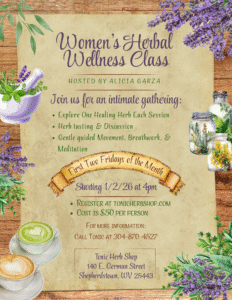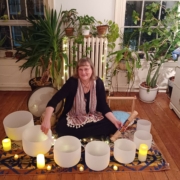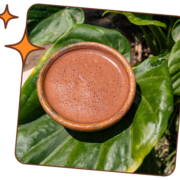UPCOMING EVENTS
Women’s Herbal Wellness Class Series
with Alicia Garza
First two Fridays of the month

January 2nd & 9th
@ 4:00 pm
*** Stick around for Terrie’s Sound Bath afterwards***
*************
Grounded Sound Baths
Fridays January 2nd & 9th
6:00 pm
(Come after Alicia’s Wellness Class)

Connect with Mother Earth as you immerse yourself in the soothing sound of crystal and Tibetan singing bowls and other meditative instruments for a deeply relaxing & healing inward journey. Grounding mats provided.
*************
Return of the Light:
Plant Allies for Stress, Depression, and Fatigue
with Kat Maier

Saturday January 31st, 2026, 10am – 5pm
Heart-Opening Cacao Ceremony

Sunday Morning Tea Ceremonies

with Silvy Franco
Join Silvy for a meditative ceremony to commune with Camelia sinensis. Come for quiet reflection as you sip on several cups of tea following Japanese tradition. Ceremony begins at 9:30 am and goes for an hour. Pre-registration is required.
Suggested Donation: $25




Echinacea
/in Herb of the Month /by Ashley DavisEchinacea is a native perennial that supports our immune system, helps our bodies to remove toxins and poisons, and keeps our blood and skin healthy. Yes, you can use it for colds & flus, but traditionally it was used to treat snakebites. It’s also helpful for acne and allergies! Echinacea is a great ally for this time of year as we feel the detoxifying pull of spring yet are still in the midst of cold & flu season.
BOTANICAL NAME: Echinacea angustifolia, E. purpurea (Echinacea angustifolia is endangered. Use only organically cultivated sources of this species. Echinacea purpurea is easier to grow and much more abundant)
COMMON NAMES: Purple coneflower, Coneflower, American Coneflower
FAMILY: Asteraceae
PARTS USED: Root, leaf and flower
BOTANICAL DESCRIPTION: Echinacea is a perennial herb that is 6”–24” tall with a woody taproot. It has one to several rough hairy stems that are mostly unbranched. The leaves are alternate, simple, and narrowly lance-shaped. The stem leaves are widely spaced and attached alternately to the lower half of the stem. Edges of leaves are toothless and have three distinct veins along its length. Stem and leaves are rough and hairy to touch. Echinacea flowers look like lavender sunflowers. Flowerheads are 1.5” – 3” wide and are at the ends of long stalks. They bloom in summer.
GROWING/HARVESTING/PROCESSING: Echinacea purpurea and E. angustifolia are native east of the Rocky Mountains, and in the Atlantic drainage area, predominantly the Great Plains and central United States and adjacent areas of Canada. The genus range is from Alberta in the north to almost the Gulf of Mexico in Louisiana and Texas in the south, and from the Ohio oak savannas, glades of Tennessee, and the Carolinas in the east, to the Rocky Mountain foothills in the west.
Seeds require a cold/moist stratification period to sprout. Echinacea thrives in full to partial sun and needs at least four hours of sunlight per day. Echinacea flowers are ready to harvest when the buds start to open, which is usually around 90-140 days after planting. Leaves and flowers can be harvested in the early summer when the flower starts to bloom. To harvest roots, make sure your plants are at least 3 years old. Dig up the root in the fall and slice in half with a clean knife. Replant one half to continue growing.
ENERGETICS AND TASTE: Cooling, drying, bitter
ACTIONS AND PROPERTIES: Alterative, antiseptic, anti-venomous, antiviral, immune stimulant, lymphatic
INDICATIONS: Echinacea aids in the process of antibody formation and stimulates the production of white blood cells. It helps strengthen and clear lymph nodes, making it a very useful alterative and treating colds and flus and a variety of toxins. Echinacea inhibits the enzyme, hyaluronidase, which breaks down compounds that bind cells together, thus inhibiting the spread of infections.
Useful for infections of the upper respiratory tract such as laryngitis, tonsillitis, and for catarrhal (mucous-y) conditions of the nose and sinus. Combined with goldenseal it is an excellent remedy for bacterial and fungal infections of the sinuses. It is also supportive for allergic rhinitis in combination with other anti-inflammatory herbs such as goldenrod, turmeric, nettle, quercetin, and reishi.
Several studies indicated that it can help, prevent, treat and shorten the duration of viral illnesses. As an immune enhancer, echinacea is also indicated for gingivitis (oral rinse), vaginal yeast infections and UTIs (internally). Topically, Echinacea is a wonderful remedy for wounds, bites and stings.
Echinacea activates macrophages on its own, independent of T cells. The echinacoside glycosides appear to be the primary ‘antibiotics’ in echinacea and function synergistically with other active constituents in the plant. The polysaccharides possess good antitumor, bacteriostatic and anesthetic properties. The active constituents within the roots have shown mild activity against Streptococcus and Staphylococcus aureus. Caffeic acid derivative echinacoside reduced growth and rate of production of Trichomonas vaginalis and halted recurrence of Candida albicans infections.
Traditional Uses for echinacea were to correct “bad blood,” (toxins, infections or poisons in the blood). This can be seen as a tendency to sepsis and malignancy, sloughing and spreading ulcerations, foul discharges, pus, dirty-brownish coating on the tongue. It was a remedy for gangrene, typhoid, septicemia, malignant carbuncles, abscesses, diphtheria, and snake bite. Native Americans used it for rattlesnake bites, and today it is used for cellulitis from bee stings and to prevent tick-borne diseases from taking root in the host following a bite. In all of these conditions, echinacea works best when taken early, at the first signs of infection, and in frequent doses. For snake and insect bites, it is best to use both topically as well as internally.
Echinacea was first popularized as a remedy for septicemia and has been successfully employed in injuries complicated with septic infection. Epidemic influenza was only occasionally ameliorated by Echinacea. Modern research shows that echinacea can help to reduce the duration of a viral infection, and in many cases, it reduces the volume of mucus in the upper respiratory tract, but it does not remove the symptoms entirely. Fresh plant tincture works best, but water-based preparations can be used for more chronic conditions, and it has to be used in therapeutic doses for it to be effective.
PREPARATION AND DOSAGE: Soluble in water, alcohol, glycerin
CHEMICAL CONSTITUENTS: Caffeic acid esters including echinacoside (in E. angustifolia only) and cichoric acid (in E purpurea only) alkylamides, mostly unsaturated isobutyl amides, polysaccharides (including echinacin B); polyacetylenes, and essential oil
PHARMACOLOGY: The root of Echinacea contains inulin, which activates the alternative complement pathway. The polysaccharides are non-specific T cell activators and stimulate T-cell mitogenesis, phagocytosis by macrophages, increase in TNF IL-1, lg binding, and increases neutrophils. Echinoside is antibacterial.
The alkylamides and cichoric acid are potent stimulators of macro phagocytosis. Echinacea also supports the immune system by activating natural killer cells and increasing the production of interferon, an important part of the body’s response to viral infections. (8,9). Together, these constituents increase the production and activity of white blood cells and the non-specific immune response.
Echinacea also inhibits hyaluronidase, stabilizing mucosal connective tissue against invasion by pathogenic organisms. Echinacea also has antioxidant activity. Root extracts of E. angustifolia, E. pallida, and E. purpurea are capable of scavenging hydroxyl radical and suppressing the oxidation of human low-density lipoprotein. (12)
CONTRAINDICATIONS:
Allergic hypersensitivity to plants in the Asteraceae family is common, therefore exercise caution with administration in atopic patients.
Toxicity: lmmuno-suppression has been reported at doses 1000 times a recommended dose.
DRUG INTERACTIONS:
COMBINATIONS:
FLOWER ESSENCE USE: Echinacea flower essences for those who lack a sense of identity because of the anonymity of modern life, or who, because of physical or emotional trauma, feel as if they are ‘falling apart.’ Such threats to the sense of self may underlie many immune-related illnesses. It strengthens the sense of self and engenders a feeling of wholeness. Echinacea is used specifically for those who feel shattered by severe trauma in their lives. They may feel profoundly alienated, unable to contact that inner place of strength and calm. Echinacea helps to bring about a sense of wholeness, and greater resilience when under enormous stress.
An Echinacea person may feel cross and irritable and does not wish to be contradicted. So nervous they cannot study or concentrate, their head feels dull, and their senses numbed. They may also be depressed and out of sorts, particularly in the afternoon. They are generally worse after eating, and after physical and mental exertion and better for rest.
ETHNOBOTANY/HISTORY/FOLKLORE: The genus name Echinacea is derived from the Greek ‘echinos’ which means hedgehog and refers to the appearance of the spiny seed head.
Echinacea was used at length by Native Americans and by traditional herbalists in the United States and in Canada. One of the first written accounts was by an equestrian from Louisiana who used this herb topically on horses. According to the ethnobotanical work, Uses of Plants by the Indians of the Missouri River Region, written in 1914 by Melvin Gilmore, “echinacea seems to have been used as a remedy for more ailments than any other plant.” A variety of tribes, including the Pawnee, Dakota, Omaha-Winnebago relied heavily upon this plant. It was used for situations ranging from swellings to distemper in horses. This herb was administered as a fresh juice, herbal smudge or smoke, and often either the leaf or root was simply chewed on. Echinacea was used traditionally for supporting the immune system and also for topical use.
The Eclectic physicians in the United States popularized Echinacea in the late 1800’s showing particular interest in E. angustifolia. John Uri Lloyd and John King were major proponents of this herb, extolling its virtues far and wide for several years until it became the single most widely used herb by the Eclectics. It was all the rage until the Eclectic schools closed down in the mid 1930’s at which point the popularity of echinacea declined in the United States. It fell out of fashion until the 1970’s when herbalists resurrected it. However, during this time, E. purpurea was gaining recognition in Germany. Ironically, E. angustifolia was the species that most traditional herbalists and Native Americans used, yet E. purpurea was the species that the Germans ended up researching and therefore the one that became the most popular, first in Europe, and then in the United States. Thus, the species which had the most substantiated historical evidence, has the least scientific research. As the story goes, in the 1950’s the Swiss naturopathic doctor, Dr. Vogel, came to the U.S. to study Echinacea in South Dakota. He brought seeds back which he believed were from E. angustifolia and gave them to a German doctor who planted them and made a preparation. Soon it was discovered that the species was actually E. purpurea which is why it became so popular and widely studied in Europe.
REFERENCES:
*** This article is for educational purposes only. The information contained here has not been reviewed by the FDA and is not intended to diagnose, treat, cure or prevent any disease ***